Newsletter - March 2023
The transportation industry has experienced significant advancements in recent years, with innovations improving vehicle efficiency, safety, and performance. However, one area that still requires further progress is battery diagnostics.
TMC 2023, a Transportation Technology Exhibition held in Orlando, showcased new systems that detect vehicle anomalies and alert drivers to upcoming maintenance needs. Yet, unexpected battery failures persist, indicating a need for more reliable diagnostic solutions. This article explores the importance of battery capacity measurement and its role in predicting battery end-of-life more accurately.
Challenges in Battery Diagnostics
Traditional methods for determining when to replace a battery often fall short, as service personnel typically rely on battery testers that only measure voltage and internal resistance, reflecting Cold Cranking Amps (CCA). Battery capacity, the leading health indicator, is overlooked until low energy levels hinder engine cranking. Although capacity serves as the most reliable end-of-life indicator, it is difficult to measure accurately.
Battery Management Systems (BMS) installed in vehicles monitor voltage, current, and temperature to detect battery anomalies. However, BMS technology cannot reliably measure capacity because voltage remains unchanged as capacity fades, and internal resistance increases only slightly. Moreover, internal resistance and capacity do not exhibit a correlation.
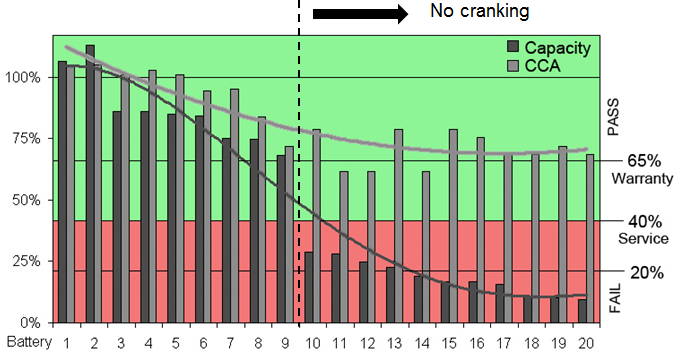
Figure 1: Capacity and CCA of 20 batteries.
CCA stays high while the capacity gradually drops.
Test Method: CCA was assessed with the Spectro CA-12; capacity was taken with an Agilent load bank by applying a full cycle according to BCI standards.
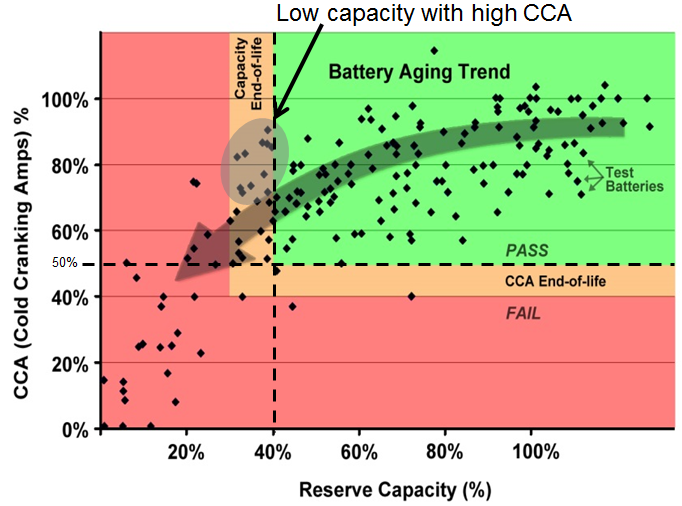
Figure 2: Capacity fade of 175 AGM batteries.
Most batteries fail due to capacity fade shown by the arrow. Few batteries fail due to low CCA. The batteries tested involve trunk-mounted AGM.
Test Method: Capacity and CCA were tested according to DIN and IEC standards.
U.S. patent 7,072,871, U.S. patent 6,778,913, U.S. patent 10,302,709
Figures 1 and 2 illustrate the CCA and capacity of aging starter batteries. A battery can retain as little as 40% capacity and still crank the engine. Spectro test devices designate a pass/fail threshold at 40% capacity, providing a grace period of 6 to 12 months before the next service. Engine cranking becomes uncertain when capacity falls below 30%.
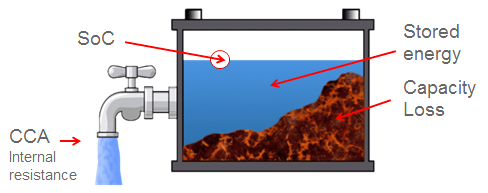
Figure 3: Depiction of SoC, CCA and capacity
While the 40% threshold is appropriate for starter applications, it becomes less reliable when a battery also provides auxiliary power, such as supplying electrical power to the cabin when the engine is off. Drawing additional energy can deplete reserves and potentially hinder the engine's ability to start.
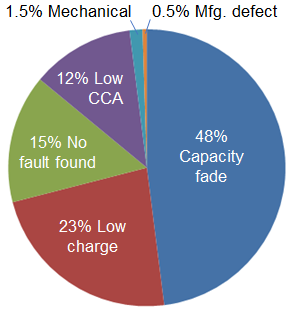
Figure 4: Cause of battery failure
Figure 4 demonstrates failure modes of 800 AGM starter batteries, with low capacity being the leading cause of drivers becoming stranded. Capacity fade often goes unnoticed as long as engine cranking remains robust. Predictive battery analysis necessitates both capacity and CCA readings.
Low charge is frequently attributed to city driving with auxiliary systems engaged. Batteries are often replaced without any apparent faults, a practice that advanced battery test devices could mitigate. Low CCA levels at 12% may result from heat failure, sulfation, corrosion, or other defects.
Spectro™: A Solution for Accurate Battery Diagnostics

Figure 5. Battery test resembles face recognition
Spectro™ evaluates battery capacity in a 30-second test by examining a battery's electrochemical properties and comparing them to data stored in a lookup table called a matrix, a process akin to facial recognition. In this context, facial features take the form of Nyquist plots, which are compared against a matrix utilizing fuzzy logic or Artificial Neural Networks. Creating a matrix involves scanning batteries with diverse performance levels.
Owing to similarities in architecture, starter batteries share a generic matrix with pass/fail thresholds. Mature, battery-specific matrices can provide more detailed performance information. The Spectro test is non-invasive.

Figure 6: Complex EIS assesses battery capacity, CCA and SoC.
Spectro™ applies a sinusoidal signal ranging from 2 kHz to 100 mHz, followed by filtering and magnitude extraction. Modeling and data fusion are employed to derive capacity, CCA, SoC, and other essential battery readings. The Spectro Modular is available as a line product for testing starter batteries, with the compact device interfacing with a host via Bluetooth to display test results.
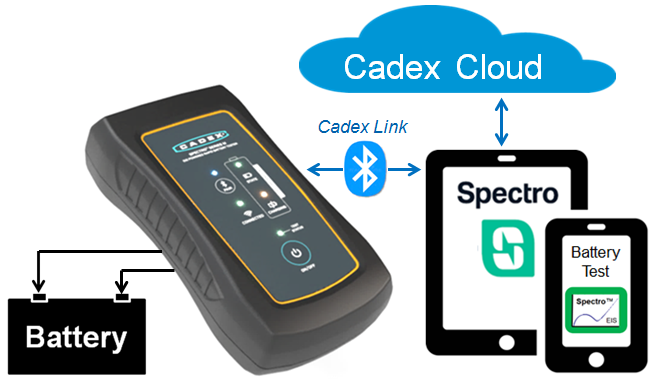
Figure 7: Spectro Modular testing starter batteries with host.
The Modular also generates Nyquist plots, as described in Pattern Recognition, to assist battery manufacturers with quality control, as well as research labs and academia. Optional cloud analytics can facilitate fleet management and reveal the remaining useful life (RUL) of batteries, the ultimate objective in battery management.
Conclusion
As the transportation industry continues to evolve, there is a pressing need to address the challenges in battery diagnostics. Traditional methods of determining when to replace a battery are insufficient, as they often overlook the critical parameter of capacity. The introduction of advanced battery testing devices, such as Spectro™, offers a more accurate and comprehensive approach to assessing battery health by considering both capacity and CCA readings.
By utilizing cutting-edge technology, such as non-invasive testing and cloud analytics, Spectro™ allows for improved fleet management and better determination of a battery's remaining useful life. This solution not only enhances battery diagnostics but also contributes to the overall efficiency, safety, and performance of vehicles in the transportation industry. As a result, drivers can experience fewer unexpected failures, and service personnel can make more informed decisions regarding battery replacements.
